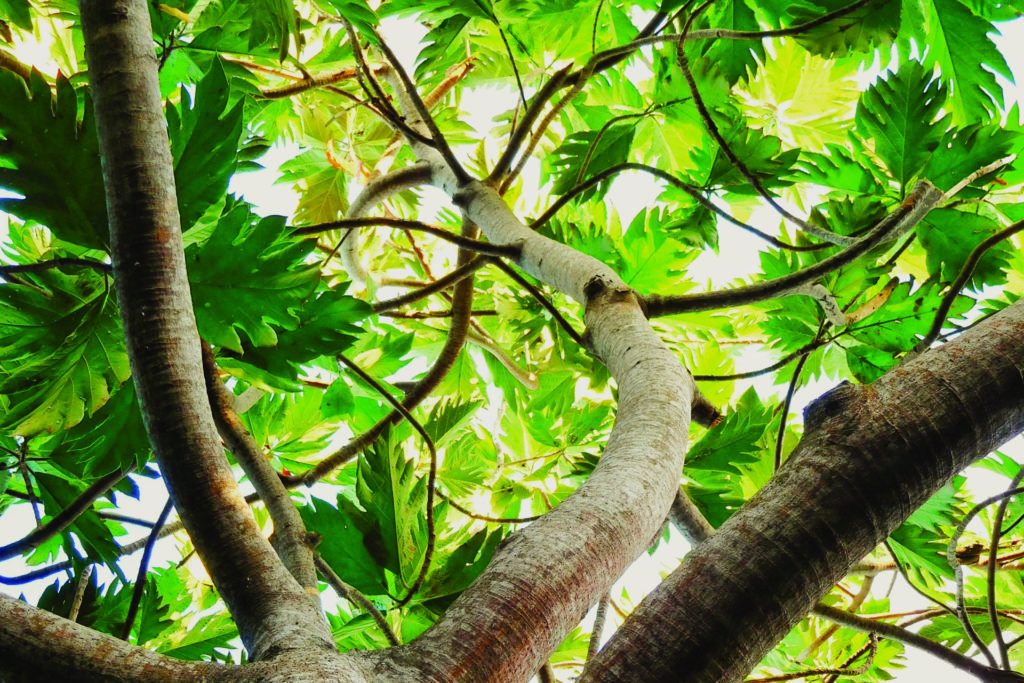A Tiny Orchard’s Potential Role in shaping Kaua‘i’s Sustainable Future
Tucked away on a 40-acre plot in back of Kaua‘i Community College (KCC), a tiny orchard of 64 breadfruit (ulu) trees prospers, shielded by the protective walls created by mature vegetation and fed by the Garden Island’s clean air. It may seem unremarkable to the casual observer at first glance, but often looks are deceiving—as this small orchard plays a key role certainly in Kaua‘i’s and possibly the state’s sustainable future.
Launched in December 2014, the Ulutopia Breadfruit Research Project is a joint venture between KCC and the National Tropical Botanical Garden’s (NTBG) Breadfruit Institute. It is the brainchild of Susan Murch and Diane Ragone of the NTBG Breadfruit Institute, and Sharad Marahatta, formerly with KCC and currently an assistant professor at UH Hilo’s College of Agriculture, Forestry and Natural Resource Management. Brian Yamamoto, professor of biological science at KCC, is the current project director.
For the unfamiliar, breadfruit is a staple tree crop found in Hawai‘i and throughout Polynesia that is high in complex non-gluten carbohydrate, low in fat and cholesterol. Breadfruit’s potential to alleviate hunger in the tropics has been underutilized and neglected according to agronomists. The Ma‘afala variety that was selected for Ulutopia originates from Samoa and Tonga and has been grown in Hawai‘i for decades. This variety was selected due to its availability, high nutritional content in potassium and carotenoids, ability to bear fruit in two-and-a-half to three years, and a longer than average fruiting cycle.
During the Ulutopia establishment period, most of the agronomic activities (such as breadfruit seedling management, fertilizer application and irrigation) were performed with the involvement of students. In addition to the agriculture students, students in construction trades assisted in building a shelter at the site and providing piping for irrigation. Experiments at Ulutopia have included four fertilizer splitting treatments and two cover crop treatments in 2016 and changes in fertilizer treatments in 2019. The breadfruit plants have now completed their first year harvest.
“Nowhere else has such a study been conducted and it will help farmers make informed decisions about establishing and managing breadfruit orchards,” added Ragone.
Ulutopia is a project of the Innovation Center at KCC. The mission of the Innovation Center is to identify issues internally and externally with an indigenous lens and cultural perspective to support learning experiences and hands-on projects that are faculty led, interdisciplinary, and address community needs. Through the Innovation Center’s affiliations with the Office of Continuing Education and Training, KCC plans to develop an agribusiness plan for breadfruit production on Kaua‘i.
Additionally, Ulutopia is an integral part of the KCC’s Cognition Learning Center (COGS), another project of the Innovation Center. The mission of the COGS is to inspire and encourage inquiry, exploration, and hands-on learning to excite students of all ages, particularly in the area of sciences. It is essential to reach students early in their educational careers and to expose them to the potential of agriscience as a future for a sustainable Hawai`i.
“The primary focus of the project is to provide a living laboratory to study and develop best practices and collect long term data on agronomic cultivation of breadfruit in Hawai‘i,” said Yamamoto. “Another important objective is to develop undergraduate students’ research skills.”
Ulutopia is currently funded in part through a U.S. Department of Agriculture — National Institute of Food Agriculture Alaska Native Serving- and Native Hawaiian-Serving Institutions Educational Grant through a project entitled Hi!ag: Fostering Vibrant Local Agriculture at the University of Hawai‘i. The field research project provides undergraduate students with place-based, experiential learning opportunities through hands-on field activities and directed studies research projects. Results from the project have been shared across the University of Hawai‘i System and offers opportunities for further collaboration.
The breadfruit produced from the research project has created new research potential. The fruit can be sold as a fresh fruit commodity requiring research into shelf-life, storage and transportation of fruit. The fruit also can be converted into additional agricultural value-added products.
“Now that the trees are producing fruit, we are looking at fruit use in our culinary programs to stress nutritional value and new product recipes,” said Yamamoto. “We are also looking at new products that can be made from gluten free breadfruit flour.” Agriculture in Hawai‘i has transitioned from large scale corporate agriculture production to diversified entrepreneurial agribusiness that produces for local markets. This new direction requires a large workforce that is well-trained in agriscience and agribusiness. Therefore, there is a need to educate more students in agriculture, food and natural resource management. This research project at Kaua‘i Community College provides a local learning environment for students and fosters local agriculture in the community. It will contribute to breadfruit research, inspire and energize students about agriculture, and provide them with inspiration to develop and produce locally grown staple foods such as breadfruit, taro and sweet potato for Kaua‘i’s community and economy.

